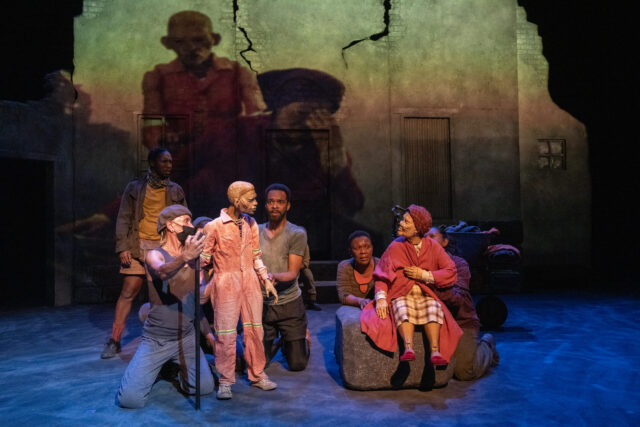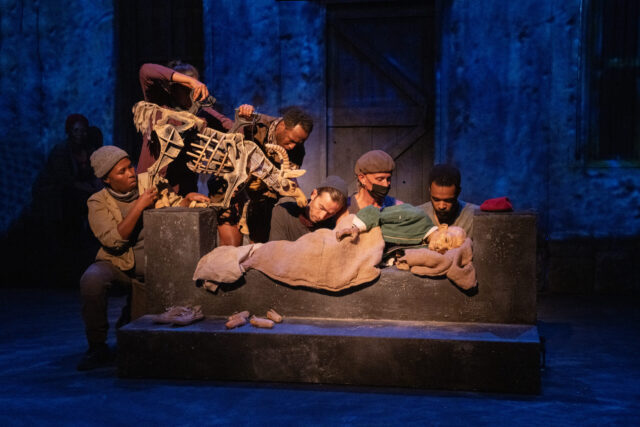
Life & Times of Michael K tells a heart-wrenching story set in war-torn South Africa (photo by Richard Termine)
LIFE & TIMES OF MICHAEL K
St. Ann’s Warehouse
45 Water St.
Through December 23
718-254-8779
stannswarehouse.org
Lara Foot’s extraordinary adaptation of J. M. Coetzee’s 1983 Booker Prize–winning novel, Life & Times of Michael K, begins with a group of people huddling around a figure wrapped in a blanket on the ground of a dark, bombed-out area, like an infant left on its own to face a harsh struggle. The figure is lifted up to reveal a wooden puppet of a young man with a harelip, seemingly born from the earth. For the next two hours, he goes on an adventure that takes him across poor and desolate sections of South Africa during a fictional civil war in the time of apartheid.
He is part Josef K from Kafka’s The Trial, part Chauncey Gardiner from Jerzy Kosiński’s 1970 novel, Being There, and subsequent Hal Ashby film, with a bit of Jack Crabb from Thomas Berger’s 1964 novel, Little Big Man, made into a 1970 film by Arthur Penn. On his journey, he faces bureaucratic red tape, tragic loss, severe hunger, and violence as he survives scene after scene in which it is hard to tell the good people from the bad, all the while just wanting to tend to a garden, bringing new life to a dangerous world. “It is because I am a gardener, he thought, because that is my nature,” one of several narrators says. “The impulse to plant had been reawakened / now, in a matter of weeks, he found his waking life bound tightly to the patch of earth / he had begun to cultivate / and the seeds he had planted there.”
It’s a haunting tale told through puppetry — Michael K is a life-size wooden puppet operated by Markus Schabbing, Craig Leo, and Carlo Daniels, who voices the character, while Michael K’s mother, Anna K, is animated by Faniswa Yisa, Roshina Ratnam, and Nolufefe Ntshuntshe. Designed by Adrian Kohler, who cofounded Handspring Puppet Company with puppetry director Basil Jones, the puppets are magically imbued with emotion by the handlers, who are out in the open, not hidden from the audience; when Michael K is given a pie, the handlers actually eat it. However, the handlers also represent how Michael K and his mother are controlled, never free; when left to himself, Michael K crumples on the floor, unable to move. As he says, “I do not know what is going to happen. The story of my life has not been an interesting one; there has usually been someone to tell me what to do next; but now there is no one, and the best thing seems to be to wait.”
The journey starts with Michael K determined to bring his ailing mother back to their home in Prince Albert, a trip for which he constructs a special rickshaw cart for her. Along the way he encounters bullies, armed soldiers, a goat, work camps, thieves, children playing, and extreme poverty and hunger, which is made palpable when Michael K removes his shirt, revealing bones with nothing inside. Although race is never mentioned specifically, Michael K is treated differently, and often negatively, because of his harelip, a physical manifestation that makes him feel less than, a metaphor for his color.
The other, nonpuppet characters are portrayed by Sandra Prinsloo, Andrew Buckland, Wessel Pretorius, Billy Langa, Ntshuntshe, Yisa, and Ratnam, including cyclists, soldiers, bus passengers, guards, police officers, bullies, nurses, clerks, and others; Ntshuntshe excels making baby noises. They also serve as narrators, relating important plot developments with Coetzee’s poetic language: “Michael did not miss his mother. No, he did not miss her, he found, except insofar as he had missed her all his life.” “Because of his face Michael did not have women friends. He was easiest when he was by himself.” “The problem that had exercised him all those years ago behind the bicycle shed at Huis Norenius, namely, why had he been brought into the world, had finally received its answer: He had been brought into the world to look after his mother.”
The effective, naturalistic costumes are by Phyllis Midlane, with sound by Simon Kohler and lighting by Joshua Cutts that puts you right in the middle of the action on Patrick Curtis’s war-torn set, enhanced by Kyle Shepherd’s original music. Video projections feature extreme close-ups of Michael K in which his face and body dominate the back wall; the photography and film are by Fiona McPherson and Barrett de Kock, with videography and editing by Yoav Dagan and projection design by Kirsti Cumming.
In such recent shows as The Jungle, Into the Woods, Life of Pi, and Wolf Play, puppets have been used ingeniously; Michael K continues that welcome trend.

Michael K encounters a goat in unique adaptation of novel by J. M. Coetzee (photo by Richard Termine)
One characters sums it up when he tells Michael K, “Why should we run away if we have nowhere to run?”
A collaboration between Foot’s Baxter Theatre Centre (Mies Julie, The Inconvenience of Wings), Handspring Puppet Company (Little Amal, War Horse), and the Dusseldorfer Schauspielhaus, Life & Times of Michael K is about trying to find one’s place in a world that is overwhelmed by sociopolitical ills, where one individual can get trapped in a system that refuses to acknowledge who he is and what his needs are. It might be set in South Africa, but it is a timeless, universal story, told here in a moving and poignant way.
[Mark Rifkin is a Brooklyn-born, Manhattan-based writer and editor; you can follow him on Substack here.]